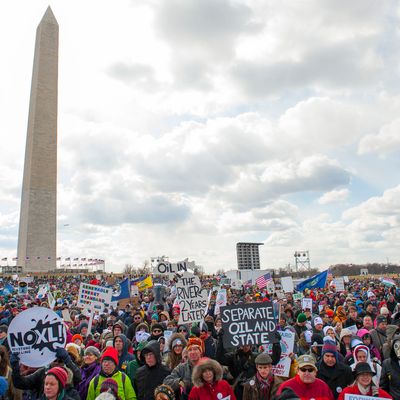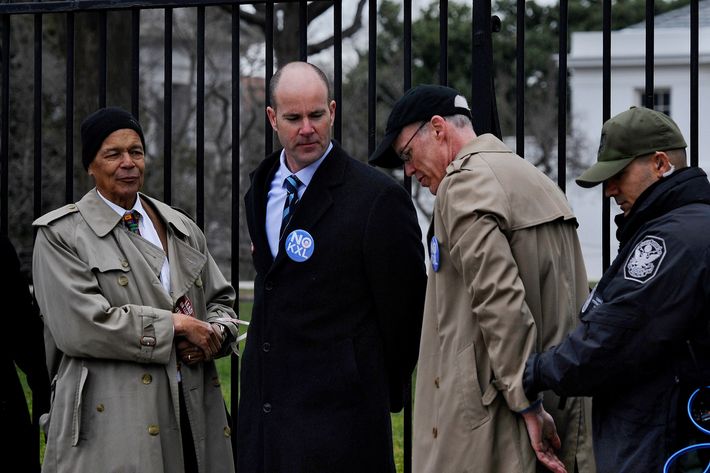
“To an increasingly disillusioned environmental movement,” environmental activist Bill McKibben writes in the Huffington Post, “Keystone looks like a last chance.” It may be a last chance for the movement McKibben has helped lead — he has spent several years organizing activists to single-mindedly fight against approval of the Keystone pipeline — but Keystone is at best marginally relevant to the cause of stopping global warming. The whole crusade increasingly looks like a bizarre misallocation of political attention.
My view, which I laid out in a long feature story last spring, is that the central environmental issue of Obama’s presidency is not Keystone at all but using the Environmental Protection Agency to regulate existing power plants. That’s a tool Obama has that can bring American greenhouse gas emissions in line with international standards, and thus open the door to lead an international climate treaty in 2015. The amount of carbon emissions at stake in the EPA fight dwarf the stakes of the Keystone decision.
Estimates differ as to how much approval of the Keystone pipeline would increase carbon emissions, but a survey of studies by the Congressional Research Service found that the pipeline would add the equivalent of anywhere between 0.06 percent to 0.3 percent of U.S. greenhouse gas emissions per year. By contrast, the Natural Resources Defense Council’s proposal for EPA regulations would reduce U.S. emissions by 10 percent per year – 30 times the most pessimistic estimate of Keystone’s impact.
Of course, it’s far from clear Obama will settle on a regulatory proposal as aggressive as the NRDC’s. But that’s just the point. Even slight gradations in the strength of possible EPA plans matter more than the whole fate of the Keystone pipeline. And yet McKibben and tens of thousands of his followers are obsessed with a program that amounts to a rounding error at the expense of a decision that really is the last chance to stop unrestrained global warming.
How did they arrive at such a strange choice? The answer can be found in my friend Ryan Lizza’s deeply reported account in The New Yorker last month. Lizza’s fascinating story does not explicitly support the anti-Keystone movement, but it structures the narrative in a way that generally accepts the movement’s assumptions and casts them in a heroic light. Nonetheless, the facts in his account show how environmental activists stumbled onto the Keystone issue, then clung to it even as the rationale for their decision collapsed.
In the spring of 2011, James Hansen wrote, in a brief blog post, that developing the Canadian tar sands would amount to “game over” in the fight to contain climate change. Hansen’s post came out in the wake of the collapse of cap-and-trade legislation, when environmentalists were searching for an issue around which they could build a grassroots movement. McKibben read and was deeply influenced by Hansen’s conclusion, which helped inspire him to build an environmental movement centered around blocking the Keystone pipeline.

Sprinkled throughout Lizza’s story are statements by various supporters of the anti-Keystone movement to the effect that they seized on Keystone because they needed something to rally environmentalists on. John Podesta, an adviser to Tom Steyer, who has helped finance and organize the movement, tells Lizza, “People were beginning to doubt the president’s commitment.” Keystone “became the test of the question: Are we going to do anything long term about climate change?” Kate Gordon, another Steyer adviser, tells him, “The goal is as much about organizing young people around a thing. But you have to have a thing.” Lizza himself writes, “For many activists, the opposition to Keystone isn’t really about the pipeline … they want Obama to use Keystone as a symbolic opportunity to move America away from fossil fuels.”
Lizza doesn’t frame these observations as a damning indictment, but they do amount to one. The logic of the decision was the opposite of what it appeared to be: Rather than build a movement as a means toward the end of stopping Keystone, Keystone was the means toward the end of building a movement. Cap and trade was dead, Keystone was the best thing they had, so they went with it.
Later in the piece, Lizza notes as an aside that the back-of-the-envelope calculation undergirding Hansen’s “game over” warning turns out to be wildly incorrect:
Hansen’s dire warning about Canada’s unconventional oil deposits was based on the assumption that every ounce of oil in the sands would be burned. (Only a small fraction of the total estimated reserves is recoverable, and doing so will take decades.)
Oh! So developing the Canadian tar sands isn’t Game Over, or anything close to Game Over? While framed in the story as a minor detail, this seems like an enormously damning fact. In much the same way that conservative Republicans initially decided to shut down the government on the mistaken belief that doing so would defund Obamacare, and had to stick with their strategy once they had rallied millions of followers to the cause, environmental activists appeared to have built a strategy upon what was at best a rickety factual premise.
The other accident at work here is one of timing. The Keystone movement developed in 2011, when environmentalists needed a cause to replace the failed cap-and-trade bill. It was only immediately following the 2012 election that the NRDC laid out a plan by which the EPA could effectively tackle existing power plants, the last big repository of unregulated emissions. The road map to solving climate change is far from certain: It involves writing a regulatory scheme to reign in existing power plants, surviving a legal challenge, and then, having credibly committed the U.S. to meeting Copenhagen standards, wrangling India, China, and others into a workable international treaty.
That plan is far from certain. But Keystone won’t affect the outcome much one way or the other. If Obama pulls off the EPA plan, then the U.S. can hit its emissions target even if it builds the pipeline. If he doesn’t, it won’t hit the target, even if it kills the pipeline.
In his latest post, McKibben does not mention the momentous EPA decision that lays ahead. He does acknowledge that perhaps Keystone may matter just a tad less than he has let on in the past, but manages to conclude that this is Obama’s fault. This is a remarkable passage:
Stopping the northern half of that pipeline from being built certainly won’t halt global warming by itself. It will, however, slow the expansion of the extraction of tar sands, though the Koch brothers et al. are busy trying to find other pipeline routes and rail lines that would get the dirtiest of dirty energy out of Canada and into the U.S. via destinations from Michigan to Maine. These pipelines and rail corridors will need to be fought as well — indeed the fights are underway, though sometimes obscured by the focus on Keystone. And there are equally crucial battles over coal and gas from the Appalachians to the Pacific coast.
McKibben begins by conceding that stopping Keystone won’t single-handedly halt global warming. Then he proceeds to go farther than that, acknowledging that it won’t stop anything at all; it will just divert the oil through other channels, and those routes would have to be shut down as well. This would seem to cast Keystone not as a last chance but as a prelude to a endless series of smaller, ultimately unwinnable fights to shut down a series of rail and pipeline routes. Then he adds that a bunch of other environmental fights turn out to be “equally crucial.”
So, maybe there’s some regret for the decision to make Keystone the end-all, be-all of the environmental movement? McKibben does indeed assess blame, but not in the place where it seems to lie. Here is the sentence that concludes the passage above:
You can argue that the president’s people have successfully diverted attention from their other environmental sins by keeping this argument alive long past the moment at which it should have been settled and a decision should have been made.
The administration diverted attention from other environmental issues? Not, say, the man in the photo below?































